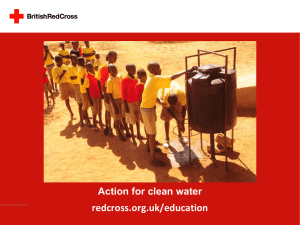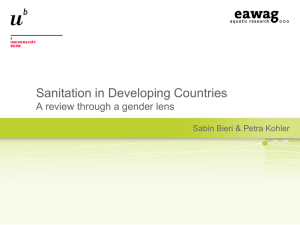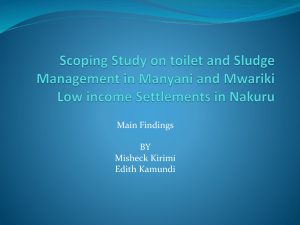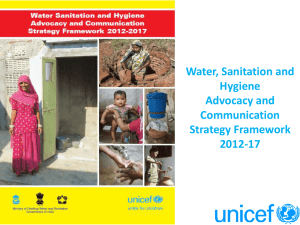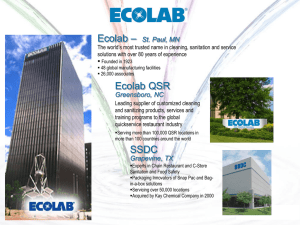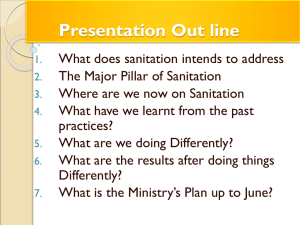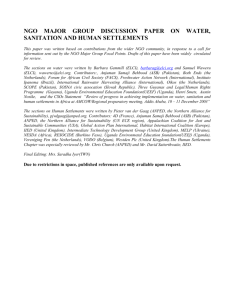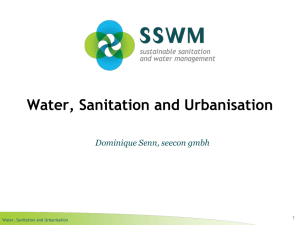Challenges of Urbanisation for Sanitation
advertisement
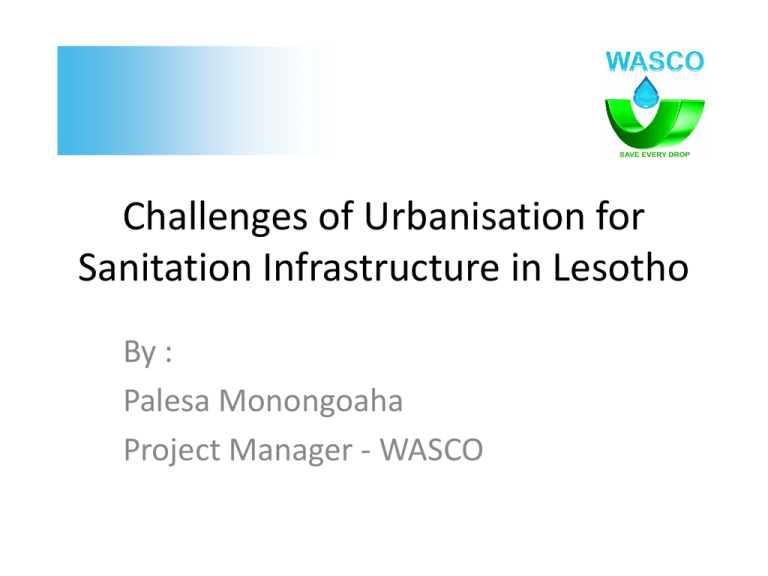
Challenges of Urbanisation for Sanitation Infrastructure in Lesotho By : Palesa Monongoaha Project Manager - WASCO • CONTENT – WASCO’S Mandate – Impact of urbanisation on sanitation infrastructure – Current Service levels – Policy Gaps for connections to sewerage – Future Strategies/key questions to be addressed by National Sanitation Policy WASCO’s Mandate • The Water and Sewerage company is mandated to provide potable water and to collect and treat wastewater in all the designated urban centres of Lesotho • Impact of urbanisation on provision of sanitation infrastructure • Migration from the Rural to the Urban areas – In accordance with the National Census, there has been a increase in migration from the rural to the urban areas – In 1996 there were an estimated 250,000 People in Maseru and that number has increased to approximately 350,000 in 2006 – The impact of urbanisation has been an increase in the demand for services, sanitation included • Rapid development of settlements – Settlements have developed at a rapid pace and provision of services has not matched this rapid development – Services are being provided in already settled areas resulting in projects that are more expensive and difficult to implement – Large areas are in some cases left unserved due to encroachment of private properties on service corridors • Settlement patterns – Our settlements are such that different income groups settle together – We have a mixture of high income, middle income and low income households – Provision of sanitation services in these mixed settlements requires a mixture of technologies taking into account the ability of households to pay for these services. • Settlements Cont’d – Most of our settlements are not planned and in most cases there are no corridors left for services. – This leaves us with no choice but to lay sewer lines inside the road reserve – Whilst this is a normal practice in the world, it comes with a number of challenges in settled areas which include: • Disruption of services (water, electricity, telecommunication) • Access issues to individual plots • The requirement to obtain permission from other authorities (Roads Directorate, Maseru Municipal Council) • Competition between water supply and sanitation – The focus in terms of resource allocation has always favoured water supply – In the process, a large backlog has been created which requires a lot of resources to bring sanitation provision up to par with water supply • Current Situation – On water supply, WASCO has three levels of Service • In-house connections • Tap-in-yard • Stand pipes – The company has 47084 water connections classified into: • Domestic and • Non-domestic • And 106 stand pipes Country-wide the Majority of which are In Maseru (39) Water Connections 2766 106 Domestic Non-Domestic Stand pipe 44318 – On the sewer side, WASCO provides sewer connections and emptying services for Conservancy tanks and VIP latrines – The company has 2141 sewer connections classified into • Domestic and • Non-domestic Sewer Connections 992 1149 Domestic Non-domestic – WASCO also provides emptying services to 12, 000 Customers mainly in Maseru – Out of a clientele of 44318 domestic water connections, only 1149 (2.6%) domestic customers are connected to the sewer – In response to this disparity in services and taking the challenges of urbanisation into account – WASCO conceptualised the Maseru Wastewater project and sought and received funding from the EUWF, EIB and the GOL for implementation of this project – The total project cost is estimated at Euro 28.6million (approx. M286 million) • The objectives of this project are: • To contribute towards Government of Lesotho efforts to achieve the MDGs • To reduce the pollution of water resources • To contribute to the reduction of water-related diseases in urban Maseru • Project Components – There are 6 services contracts • • • • • ESIA TA to PIU Design and construction supervision Mid-term review Development of the Urban Sanitation Infrastructure Master plan • End – Term Review • Project Components cont’d – 3 Works Contracts • Network contract – – app. 132 km of sewer network, three pump stations • WWTW – 7Ml/day AS treatment plant, the ultimate capacity of the plant will be 22Ml/day • Provision of on-site sanitation facilities – conversion of existing VIP latrines into water closets – Construction of new water closets – Construction of VIP latrines • The project covers the following areas – Mabote – Khubetsoana – Maqalika – Ntsirele – MASOWE • Target Groups – For 7200 (36,000 P.E.) households, classified as high income households, sewer connections have been conceptualised – For 5600 (28,000 P.E) households, classified as middle income households, water closets are to be provided and – For 7200 (36,000 P.E.) classified as low income households, VIP latrines are to be provided • Sewage collected from the reticulated areas will be treated in a treatment plant under construction at Agricultural College • Project Challenges – Since project conception in 2004, the population of Maseru is double the projected population due to substantial increase in migration from the rural to the urban areas – The pipeline routes have had to be changed due obstructions that did not exist at the time of preparing the preliminary and detailed designs – The prices of materials have increased substantially resulting in the project scope being reduced to almost half of the original scope • Challenges cont’d – Possible shortfall in financing due to the exchange rate risk - there maybe need to raise additional funding to bridge the shortfall – The project has become a major PR challenge for WASCO due to complaints from the public which include : • disruption of services • access to individual plots • Demand for compensation for damaged fences/boundary walls/ crops etc. – Concurrent implementation of projects in one area (roads and sewer network) • The Way forward for Urban sanitation in Lesotho 1. Immediately, we have to raise capital for implementation of the rest of the MWWP scope 2. In the near future • As part of the MWWP, an Urban sanitation infrastructure master plan will be developed. • Allocation of resources to bridge the gap between water supply and sanitation provision • Pacing service delivery to match development of settlements • Key questions to be addressed by National Sanitation Policy – How do we ensure that services (water supply, sanitation and other services) are in place before settlements are established – How do we provide services to the settlements that are already established taking into account the current and future challenges – How do we ensure that where sanitation infrastructure is in place that households connect to the sewer network • WASCO for its part, – has ensured that a connection is left for each household 0.5m from the plot boundary – provides connection on credit allowing up to 36months to pay • What else can be done? – For water supply basic service level is 30lcd, policy has to define the basic service level for sanitation – We say, every Mosotho has a right to the basic level of service but we should ask ourselves …. • How do we fulfil that right? • Who is responsible for fulfilling that right? Thank you



